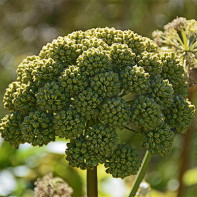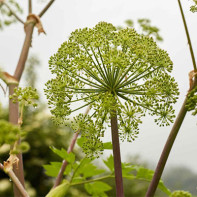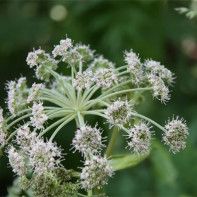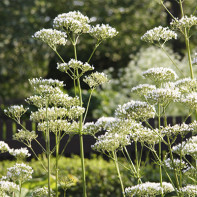Angelica: medicinal properties and contraindications
A beautiful herbaceous plant called angelica is popularly called an angelic, wolf pipe, pipe maker, kitchenette, sub-frame, and even a cannon. In the scientific literature, its second name is angelica. In nature, there are 116 types of angelica, of which only four are used for medicinal purposes: medicinal (it has the best effect), forest, marsh and Chinese.
- Chemical composition
- How it looks and where it grows
- Collection and storage
- What is the difference between angelica and hogweed
- The healing properties of angelica
- For women
- For men
- When losing weight
- Angelica in folk medicine
- Types of healing compounds
- Infusion
- Tincture
- Decoction
- Tea
- Angelica oil: properties and contraindications
- Useful properties of angelica honey
- The use of angelica in cosmetology
- To reduce skin irritation
- To get rid of fine wrinkles
- Bath for firm and smooth skin
- Mask for smoothing hair
- For fluffy hair
- Contraindications
Chemical composition
Angelica is very nice and smells pretty pretty. This aroma is given to him by the essential oil found in all parts of the plant - seeds, herbs, but most of all - in the roots. The smell of the essential oil contained in the roots is musky, it tastes spicy and burning. The oil in the seeds smells delicate, delicate, delicate, but very persistent.
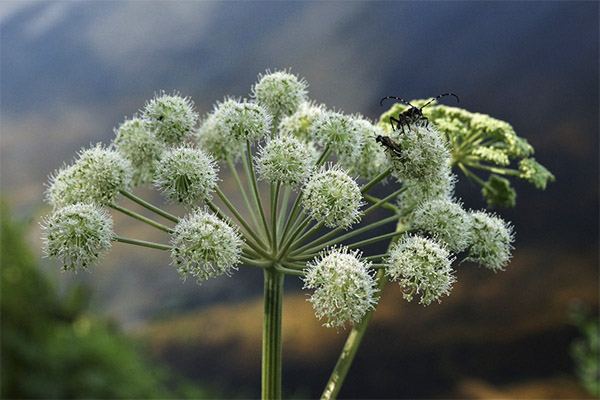
The main component of the oil is monoterpenes, or natural hydrocarbons with antiseptic, anti-inflammatory and antispasmodic effects. A recognizable smell is given to oil by legustilide - a substance that facilitates blood circulation, and sedanolide with antioxidant ability.
Also, angelica contains compounds such as falkarinol, falkarindiol. These are active photosensitizers - that is, substances that increase the sensitivity of tissues to sunlight. They are also characterized by anti-inflammatory, anticoagulant, antibacterial, anti-tuberculosis, antifungal, antiviral, neuroprotective and immunostimulating properties.
There are also organic acids, resins, tannins, wax, sugar in angelica. The leaves and flowers of the plant contain flavonoid diosmin, which has a vasoconstrictor ability. Coumarins, biologically active substances with a wide spectrum of pharmacological activity, are found in seeds. They can manifest themselves as antispasmodic, antitumor, anticoagulant agents.
How it looks and where it grows
It is impossible to ignore angelica. Its large inflorescences on tall stems with beautiful carved leaves will surely attract attention. Biologists call this form of inflorescence a complex umbrella, the diameter of which can vary from 8 to 15 cm, although each individual flower is small and nondescript, with elongated petals of a whitish or yellowish-green color and absolutely invisible cups. Angelica blooms from June to August, after which up to half a thousand seeds can ripen on each plant.
In the first year, when a young plant grows from a seed, only a root and a root rosette consisting of a bunch of leaves are formed. The following year, a tall stem with attractive leaves and large, noticeable inflorescences grows from the root.
The stalk with a bluish bloom can reach a height of up to 2.5 m. Inside, it is absolutely hollow (for this reason the people call it a pipe or pipe), it is straight from below, it branches out closer to the top.
On the stem are leaves - cirrus, large, sharp-toothed at the ends. The lower leaves can be up to 80 cm long, the upper ones are shorter. They sit on the stem in turn, are mounted on hollow petioles.
Angelica rhizome is thick (up to 10 cm in thickness), leaving vertically in the ground. At the top it has subordinate roots, at the bottom it is transformed into a core root. Inside the root there is a light yellow juice, or secret, as the botanists say.
You can meet angelica in almost any region of Northern and Central Europe, in Russia - in all areas of the European part of the country from the coast of the Barents Sea to the middle lane and the Ural Mountains. In some places it grows in Western Siberia, you can see it in the North Caucasus. The plant prefers moist, but not badly lit places, ravines, wetlands in the forest, near shrubs and along rivers, can form dense rich thickets - whole colonies. Soils he likes neutral or slightly acidic.
Angelica is an excellent honey plant and a very unpretentious plant. Therefore, if desired, it is easy to grow in the country. To do this, it is better to sow it in the fall.
Collection and storage
The angelica is used for medicinal purposes to collect all parts of the plant - from greenery and seeds to the root. But rhizomes and angelica seeds are of particular value. Both are harvested when the seeds are already ripe.
Umbrellas are collected and hung to dry in the form of bouquets, like the green parts of the plant. They dry best on a veranda or under a canopy. When the inflorescences dry, the seeds are threshed from them.
The roots are dug up, washed well with a brush, cut into longitudinal parts and dried in a dryer. If it is dry in sunny weather, you can dry it in the air, eliminating direct sunlight. The raw materials are laid out in a single layer on clean paper and mixed from time to time for more uniform drying. For the raw materials to finally dry, it will take at least 10 days.
Handle angelica carefully. Its juice contains substances that, when exposed to the skin, increase their sensitivity to light many times, resulting in reddening of the skin and even the appearance of blisters.
They store seeds and roots separately in dry glass jars with well-ground stoppers, as the raw materials easily absorb moisture, after which it loses all its aromatic properties. Subject to storage rules, angelica root does not lose its beneficial qualities for three years. Dried herbs have a much shorter period - no more than a year.
What is the difference between angelica and hogweed
When collecting angelica, it is important not to confuse it with hogweed. Hogweed is a poisonous plant. If its juice gets on the skin, it becomes covered with dark spots and blisters that heal very poorly, long and slowly. In order not to suffer from a dangerous plant, you need to remember a few differences.
- Firstly, hogweed, if you tear off its leaf, starts to smell very unpleasant. Angelica, on the contrary, has a very pleasant aroma.
- Secondly, the stalk of angelica is absolutely smooth, closer to the ground it is bluish-red in color, in the cow parsnip it is absolutely green, it may be closer to straw green, completely covered with hard hairs.
- Thirdly, in hogweed inflorescences are also covered with hard hairs, in angelica - not.
- Fourth, angelica leaves are located on the stem, at the cow parsnip they also form a basal rosette. In addition, the angelica has a general view of each individual fragment of the leaf closer to the oval, and the hogweed has a pronounced carved shape.
The healing properties of angelica
As a medicinal plant, angelica is used for a very long time. There is a beautiful legend telling that this plant was sent by God to the inhabitants of the northern part of Europe, where a plague raged at that time. Allegedly, an angel descended from heaven and brought the angelica's saving root. Since then, the plant began to be called the archangel, later this word was simplified to angelica.
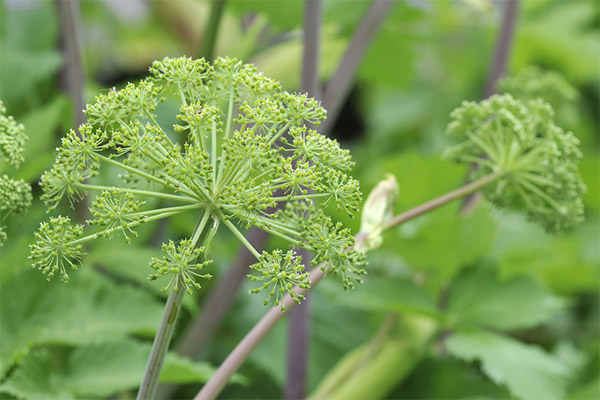
In fact, of course, angelica could not cure the plague. Scientists suggest that the patients were able to survive due to the fact that angelica activated the immune forces of people and showed its anti-inflammatory and antiseptic effects.
Medicine - both folk and official - recognize and value angelica for its extensive list of versatile beneficial properties. It has the ability to stimulate blood circulation, increase immunity, it is characterized by anti-inflammatory, expectorant, diaphoretic, diuretic, antispasmodic, anti-fermentative, effects.This medicinal plant normalizes the work of the cardiovascular and nervous systems, improves blood circulation, the production of bile and pancreatic juice, and lowers blood pressure. As rubbing it is used for pain in the lower back, gout and rheumatism. Angelica has the ability to lower cholesterol, stabilize the work of the uterus and the entire female reproductive sphere. Due to its antiseptic properties, it is used for cystitis to solve cosmetic problems.
In addition, angelica also has a good soothing and tonic effect, and it is sometimes recommended instead of valerian root.
For women
For women's health angelica is very useful and has long been used not only in Russia, but, for example, in China. He was even given the informal name "female ginseng." Since it has the ability to relieve spasms and dilate blood vessels, compounds from the plant are recommended for relieving pain during menstruation.
During menopause, angelica is also used, since it has the ability to normalize the level of estrogen in the female body, as a result of which it relieves unpleasant symptoms of hot flashes.
Angelica is also actively used in cases of polycystosis, uterine myoma, endometriosis, during menstruation to reduce too much blood discharge. It also helps to restore the cycle, disrupted by the long-term use of hormonal contraceptives.
Angelica also helps with infertility, if its cause is poor blood supply to the pelvic organs, as is often the case with women suffering from anemia or those whose workday is associated with hours of sitting in the same pose in a stuffy office. Solve these problems angelica on the shoulder.
For men
The ability of angelica to establish a hormonal background extends to men. Thus, it not only restores male power, but also prevents violations of the heart and blood vessels and helps restore lipid metabolism.
Acting on blood circulation, the plant improves microcirculation in the genitals, which helps restore potency. To do this, you just need to drink ready-made angelica tea, bought in a pharmacy and packaged in disposable bags. The anti-inflammatory and antibacterial abilities of the plant will help with infections and inflammatory processes of the genitourinary system.
When losing weight
Since angelica has the ability to activate all body processes, slimming uses its positive effect in improving metabolism. A visible result can be obtained if you use the plant simultaneously with sports and diet. Angelica will not only help to reduce weight, but it will also calm the nervous system, relieve focus on the problem of losing weight.
It is recommended to use it in the form of alcohol tinctures by exchange methods for a month, after which a two-month break is taken. You can try and non-alcoholic option in the form of infusion. These funds help fight cellulite and body fat.
Angelica in folk medicine
With the help of angelica root, many diseases are treated. For each of them there are recipes that are most suitable in certain cases. Various dosage forms are also used - these are tinctures, infusions, decoctions, tea, and even oil.
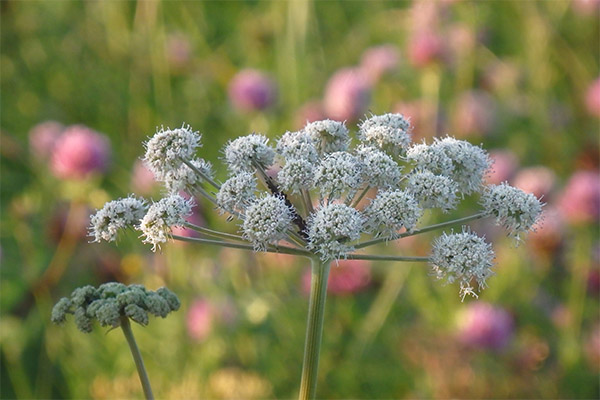
So, traditional healers store many recipes used to treat patients suffering from respiratory diseases. Essential oil from the roots of the plant is widely used to treat bronchitis, viral infections, even with the common cold. Women widely use oil to restore an irregular menstrual cycle during menopause.
Taking alcohol tinctures inside relieves pain in patients with osteoporosis, rheumatism. The same tincture can be used outside, rubbing the lower back and joints. This treatment method is also effective.
Decoction reduces sugar, it is used for asthma, intestinal problems such as colic, gas congestion, obstruction, diseases of the excretory system (inflammation of the bladder, kidney infections). If you make a decoction of angelica with honey, you get an excellent diaphoretic.It can also be used for problems with discharge of urine.
Angelica infusion is a good help for the treatment of periodontal disease, laryngitis, pneumonia, gastritis, pancreatic and liver dysfunction, urolithiasis. Due to the ability to establish blood circulation, this remedy has established itself well in the treatment of infertility. The infusion is recommended to be added to the water when taking baths, if the patient is diagnosed with neuralgia, gout, and nervous exhaustion. Such baths are also good if insomnia has tormented, joints hurt, they can not heal scratches and wounds on the skin or the skin manifestations of psoriasis or dermatitis have worsened.
Traditional medicine has learned to use even angelica juice. It is prescribed if the tooth or ear pain has become intolerable, and also instilled in the nose with a runny nose. By mixing the juice with pork fat and angelica oil, ointments are obtained that drive lice out.
Dried and powdered leaves, mixed evenly with honey, can be used for dressings on wounds, since angelica is a wound healing agent. The grass also has anthelmintic properties, for which a tablespoon of dried herbs is poured into 300 ml of white wine and insisted day, occasionally shaking. Then this composition is filtered and drunk before meals, 2 tablespoons 2 times a day.
Types of healing compounds
Infusion
- Expectorant. A teaspoon of powdered dry rhizome is poured into a thermos and 2 glasses of boiling water are poured there, tightly closed and insisted for 6 to 8 hours. Drink such an infusion 3 to 4 times a day for half an hour before eating half a glass. It is used as a diaphoretic and expectorant for bronchitis and laryngitis, as well as an antispasmodic for smooth muscle spasms.
- Sedative. Dry rhizome powder (1 tablespoon) is poured with boiling water (1 cup), insisted under the lid for half an hour. They drink such a product after filtering 3 times a day before meals, at a time 2 tablespoons. It acts as a sedative, helps relieve nervous irritability, eliminates insomnia, relieves cough, and also works well with urinary retention.
- From infertility. A tablespoon of angelica root is mixed with 250 ml of boiling water and insisted for several hours. Then the resulting mixture is well drained, divide the liquid in half and drink for the day: morning and evening.
- Herbal infusion for gastritis. 200 ml of water with a tablespoon of dried angelica herb is brought to a boil. Insist about 5-6 hours. After straining, take 4 tablespoons of infusion 4 times a day before meals. It is recommended in the treatment of gastritis with high acidity, colitis, as well as to normalize sleep with insomnia.
Tincture
- Alcohol tincture. To prepare the tincture, 200 ml of good vodka or diluted alcohol is mixed with 3 full tablespoons of angelica root powder. Put for 10-12 days in a dark room, then filter. Apply such a tincture on a teaspoon no more than 3 times a day for problems with digestion, gastritis, flatulence, as well as to normalize the activity of blood vessels and the respiratory system. It can be drunk for those who want to lose weight. This tool will help relieve muscle and joint pain. To do this, rubbing with alcohol tincture.
- Water tincture. Water tincture is an option for those who can not tolerate alcohol, including it can be given to children. Take this tincture with the same health problems as alcohol. 3 tablespoons of the root are poured with 200 ml of boiling water, insist for a day and filtered. Drink a tablespoon three times a day.
Decoction
- Broth with honey. A tablespoon of crushed dry angelica root is boiled for 5 minutes with a glass of water, left to brew for another 2 hours. After straining, they drink 1/4 cup with honey. Indications - cough, chronic pancreatitis or gastritis.
- To restore strength. 3 tablespoons of angelica rhizomes are poured with a glass of cold water and set to boil for 10 minutes. Then turn off the fire and insist another 20 minutes.This tool is drunk 2-3 times a day before meals with emaciation and loss of strength, the norm is half a glass.
- Diuretic broth. A tablespoon of seeds is boiled for 5 minutes in half a liter of water. Cool and filter when the seeds sink to the bottom. Drink 100 ml 5 times a day. To make the drink tastier, add a little honey. The broth has a strong diuretic effect.
Tea
In addition to angelica rhizomes, they take chamomile, Ivan tea, dog rose, St. John's wort, you can add other favorite herbs. All the ingredients are mixed in equal proportions, and then brewed and drunk like ordinary tasty and incredibly fragrant tea. Such a drink has a wonderful tonic effect, and it is also useful for disorders of the stomach of a neurogenic nature.
Angelica oil: properties and contraindications
Essential oil is present in all parts of the plant, but only seeds and roots are used in industrial processing, since there is most of this valuable product there. To extract it, use the steam distillation method.
Oil from the roots is used as a tonic and blood purifying agent, it has diaphoretic and antitoxic effects that allow normalizing the balance of trace elements in the body, in particular potassium. This has a beneficial effect on the work of the cardiovascular system.
It is also useful in the treatment of diseases of the digestive system. Due to the ability to normalize the hormonal background of a woman, oil is used to stabilize the menstrual cycle, and the antispasmodic properties of the product help get rid of pain during menstruation.
In addition, this oil is a strong antiseptic, which also makes it possible to use it in gynecology, as well as to alleviate the condition of patients suffering from rheumatic pains. Mixing a couple of drops of angelica oil with a small amount of olive oil, they treat a cough - the resulting mixture is rubbed into the skin in the region of the bronchi, which helps thin the sputum. Add essential oil and during inhalation, if there is a runny nose and blocked in the throat. This procedure helps to recover faster.
Seed oil is added to food for flavor. But most often it is used for cosmetic and perfumery purposes, since it has an excellent ability to improve the condition of the skin. It is just added a few drops to creams and lotions. With regular use, it is possible to cure irritation, get rid of acne, and give the skin a more youthful appearance.
Although the oil is not considered an allergenic or toxic product, its individual intolerance is quite possible. Therefore, before the start of active use, it is necessary to check whether there will be a negative reaction to it. To do this, apply it on the wrist from the inside.
In addition, the oil stimulates the contractile activity of the uterus, so it is contraindicated in pregnant women to avoid miscarriage. For the same reason, nursing mothers should not use the medicine; it can cause bleeding in them. Also, do not use oil to treat babies up to two years.
Useful properties of angelica honey
Despite the fact that human rumor ascribes a lot of amazing healing properties to angelica honey, it is not widespread. It is appreciated for its unusual delicate and delicate aroma, interesting color, which can be either amber-red or dark brown with a greenish tint, rich refined taste with a caramel note. This honey is considered high-grade, elite. It practically does not crystallize, but simply with time it becomes thick, viscous.

The composition of honey has been studied quite well. It is proved that its largest part is fructose (approximately 43%), and not glucose.Therefore, angelica honey, after consultation with a doctor, is allowed to be consumed even with diabetes, but in small quantities.
In addition to glucose, maltose and sucrose, which are traditional for honey, the angelica product contains a whole complex of all the essential vitamins, enzymes and microelements necessary for humans. There are fungicides in honey that help in the fight against bacterial and fungal infections, as well as natural antiseptics that inhibit the development of pathogenic microflora, so this is an excellent tool in the treatment of bronchitis, acute respiratory infections and acute respiratory viral infections, tonsillitis and cystitis. In addition, honey has the ability to strengthen the immune system, which makes it useful during the slushy and cold autumn-winter season, and especially to people who are weakened and undergoes serious illnesses. It will help restore strength to tired and exhausted heavy loads - both physical and mental. Honey helps to heal wounds on the mucous membranes, supports the work of the heart and blood vessels.
Women can use it to restore the normal menstrual cycle, as a prophylactic for thrush. It has been proven that honey activates lactation, but since it causes allergies in children, it is better for nursing mothers to abandon its use.
The effectiveness of honey has been proven for cosmetic procedures. So, if you apply it on your face like a mask, it will tighten the skin and give it a more youthful look. You can use angelica honey, preparing home-made scrubs based on it. Wraps with honey accelerate the elimination of cellulite, as they improve blood supply, nutrition and, accordingly, remove excess fats and toxic substances.
It is useful to use angelica honey in the evenings: it has the peculiarity of calming the body. A spoon or two of sweet product with tea will ensure a healthy sleep.
However, honey should not be abused. Since it is quite high-calorie (328 calories per 100 g), an adult for preventive purposes is enough 50-60 g per day, and during illness - no more than 100 g.
In order not to buy a fake instead of natural angelica honey, you need to remember that this product is not cheap. Its price should be very high compared to other varieties of honey. For the same purpose, it is possible to conduct an experiment to identify its flammability. If when heating on fire in a spoon, he did not change the consistency and caught fire - then this is a fake.
Such honey can be stored for years. The main thing is to keep it in a glass dish in a dark room at a temperature of no higher than 20 degrees, eliminating contact with the metal so that the valuable product does not oxidize.
The use of angelica in cosmetology
Cosmetology most often uses the antibacterial and anti-acne properties of angelica. To become beautiful, you can use it both as an external remedy and as an internal one.
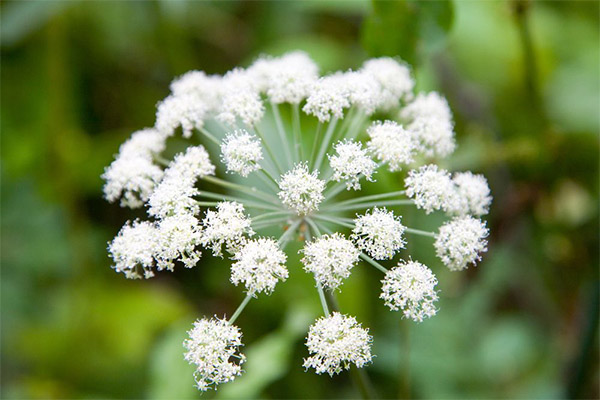
To relieve skin irritation or rejuvenation, essential oil has proven itself perfectly. Alcohol tincture often becomes the basis for anti-inflammatory lotion. In addition, the oil promotes the rapid healing of scars, wounds, microcracks, cuts, and resorption of bruises and bruises. Oil can be used as an independent product, applying it to the skin, or adding it to creams, ointments, masks, balms for hands, feet and hair, shampoos.
Angelica broth is able to transform tired skin, especially if ice cubes are made from it and then wipe their face with them.
Since angelica contains a significant amount of coumarins, it has the ability to improve blood microcirculation in the skin, which stimulates its active regeneration and tissue renewal. That is, angelica can be used to rejuvenate the skin. This property is pronounced and powerful.
In a number of formulations angelica is used to achieve a lifting effect of the skin.In addition, it also contributes to the production of collagen protein, which allows it to be used as a smoothing mask for the skin, as well as therapeutic compositions for hair.
To reduce skin irritation
Scalp the crushed root (1 teaspoon) with a glass of boiling water and leave the medicine in this water for 10 minutes, then strain. Wash your face in the mornings and evenings, you can just wipe with a cotton pad dipped in this composition.
To get rid of fine wrinkles
Prepare a decoction of angelica root: boil 3 tablespoons of the raw material in 250 ml of water for 20 minutes, then insist for the same time. Strain, take a teaspoon of the composition, mix with a teaspoon of honey and a tablespoon of homemade cottage cheese. How to grind, apply to the skin and lie down to rest for 10-15 minutes. Then wash off the mask with warm water and rinse your face with cool.
Bath for firm and smooth skin
Brew a liter of boiling water 2 tablespoons of crushed angelica root. Insist 20-30 minutes and after filtering, pour the resulting infusion into the bath. Take a bath for a quarter of an hour, while the water should not be very hot. To make the result more noticeable, take a course of such baths - from 10 to 15 procedures.
Mask for smoothing hair
Wash your hair with regular shampoo. Apply a ready-made store mask to your hair, in which to drop a little angelica essential oil - 2-3 drops will be enough. Wait 2-3 minutes, then rinse. Hair will become noticeably smoother and shinier. Repeat the procedure for a two-week course, using a mask after each shampoo.
For fluffy hair
To prepare a decoction of angelica root: pour 2 tablespoons of water into 5 tablespoons of dry raw materials. Boil the mixture for about 10 minutes, insist for another half hour. Strain, add another 1.5 liters of water and rinse hair after washing. The broth helps get rid of dandruff, makes hair fluffy and gives them a pleasant aroma.
Contraindications
They say that there are spots in the sun. And angelica: with all its benefits and a huge number of excellent medicinal properties, this plant in some cases can be dangerous. So, it is absolutely impossible to use it for pregnant women, and at any time. Nursing mothers also should not try to be treated with angelica.
It is also contraindicated with a tendency to bleeding (especially with serious uterine). Gastric ulcer, tachycardia and diabetes are also contraindications for the use of angelica.
There are people in whom the juice of the plant provokes an allergic reaction, that is, individual intolerance to angelica-based compounds cannot be ruled out.
But even if at therapeutically reasonable doses the body responds positively to angelica, then with an overdose, typical signs of poisoning may appear: photophobia, diarrhea, dizziness, nausea, vomiting, loss of consciousness, and even paralysis.
«Important: all information on the site is provided exclusively in fact-finding purposes. Before applying any recommendations, consult with a profile specialist. Neither the editors nor the authors are liable for any possible harm caused materials. "

